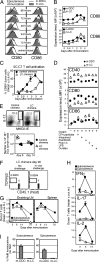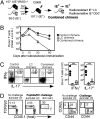Langerhans cells are precommitted to immune tolerance induction
- PMID: 22006331
- PMCID: PMC3207689
- DOI: 10.1073/pnas.1110076108
Langerhans cells are precommitted to immune tolerance induction
Abstract
Antigen-dependent interactions between T lymphocytes and dendritic cells (DCs) can produce two distinct outcomes: tolerance and immunity. It is generally considered that all DC subsets are capable of supporting both tolerogenic and immunogenic responses, depending on their exposure to activating signals. Here, we tested whether epidermal Langerhans cells (LCs) can support immunogenic responses in vivo in the absence of antigen presentation by other DC subsets. CD4 T cells responding to antigen presentation by activated LCs initially proliferated but then failed to differentiate into effector/memory cells or to survive long term. The tolerogenic function of LCs was maintained after exposure to potent adjuvants and occurred despite up-regulation of the costimulatory molecules CD80, CD86, and IL-12, but was consistent with their failure to translocate the NF-κB family member RelB from the cytoplasm to the nucleus. Commitment of LCs to tolerogenic function may explain why commensal microorganisms expressing Toll-like receptor (TLR) ligands but confined to the skin epithelium are tolerated, whereas invading pathogens that breach the epithelial basement membrane and activate dermal DCs stimulate a strong immune response.
Conflict of interest statement
The authors declare no conflict of interest.
Figures




Comment in
-
Inflammation: Under the skin.Nat Rev Immunol. 2011 Nov 4;11(12):800. doi: 10.1038/nri3113. Nat Rev Immunol. 2011. PMID: 22051889 No abstract available.
References
-
- Steinman RM, Banchereau J. Taking dendritic cells into medicine. Nature. 2007;449:419–426. - PubMed
-
- Allan RS, et al. Epidermal viral immunity induced by CD8α+ dendritic cells but not by Langerhans cells. Science. 2003;301:1925–1928. - PubMed
-
- Bennett CL, Noordegraaf M, Martina CA, Clausen BE. Langerhans cells are required for efficient presentation of topically applied hapten to T cells. J Immunol. 2007;179:6830–6835. - PubMed
Publication types
MeSH terms
Substances
LinkOut - more resources
Full Text Sources
Other Literature Sources
Molecular Biology Databases
Research Materials

